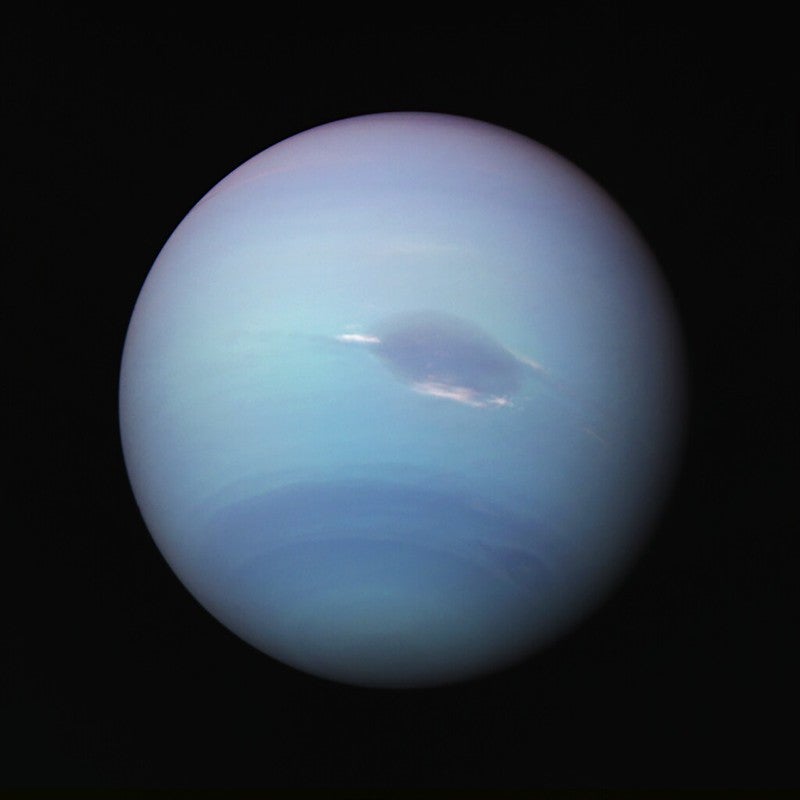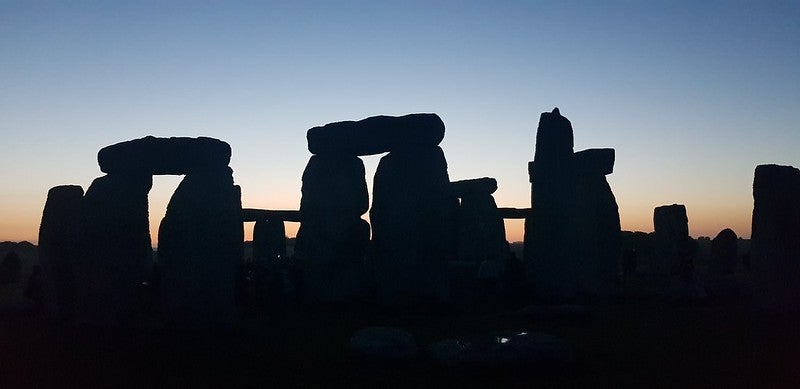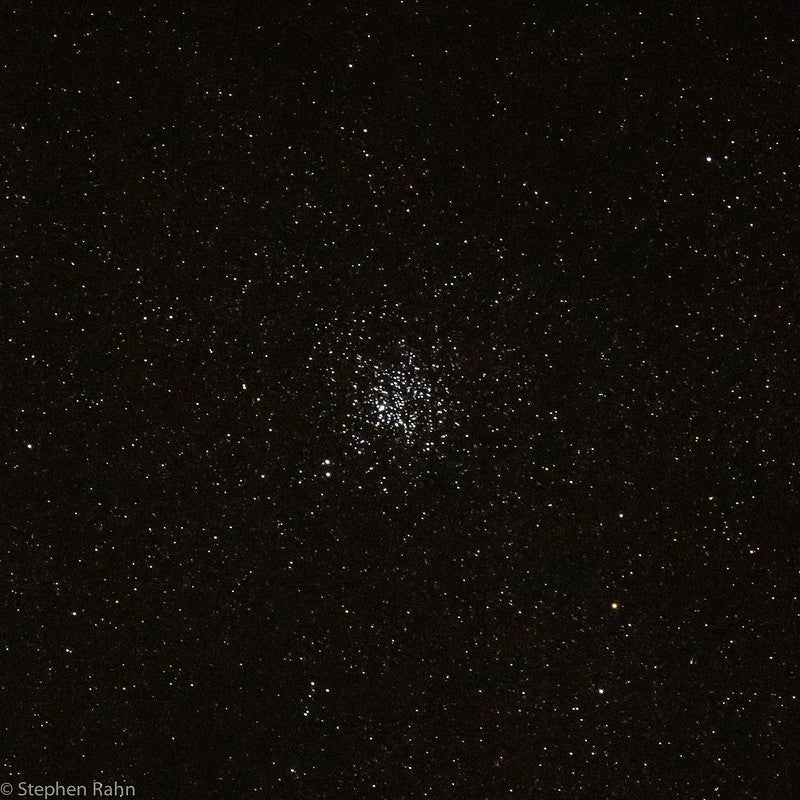
Friday, September 20
Neptune reaches opposition today at 8 P.M. EDT in the constellation Pisces. Opposition is generally the best time to view planets, as they are highest around local midnight. At that time, Neptune stands just over 45° high in the south. (When surveying the region, make sure not to mistake brighter, magnitude 0.6 Saturn for Neptune — Saturn, now in Aquarius, is visible to the naked eye, while much fainter, 8th-magnitude Neptune is not.)
However, you might want to try observing earlier in the evening — the waning gibbous Moon in Aries is still bright, but with sunset occurring earlier by the day, there’s a short dark window between sunset and moonrise this evening you can make the most of.
An hour after sunset, Neptune is 10° above the eastern horizon and lies some 5° southeast of magnitude 4.5 Lambda (λ) Piscium. At a distance of 2.7 billion miles (4.3 billion km) from Earth, the ice giant is a mere magnitude 7.7, which is invisible to the naked eye, so it requires binoculars or a telescope to observe. You can use Lambda, the southeasternmost star in the Circlet of Pisces, as a jumping-off point. Slide your gaze southeast of this star; under higher magnification, look for a parallelogram of four 4th- to 5th-magnitude stars. The northwesternmost star in this pattern is magnitude 4.9 27 Psc. You’ll find Neptune just under 2° northwest of this star this evening.
Through your telescope eyepiece, the planet’s disk will appear as a round, “flat” star spanning 2”. You may notice a distinctive bluish hue.
Sunrise: 6:46 A.M.
Sunset: 6:59 P.M.
Moonrise: 8:24 P.M.
Moonset: 9:53 A.M.
Moon Phase: Waning gibbous (90%)
*Times for sunrise, sunset, moonrise, and moonset are given in local time from 40° N 90° W. The Moon’s illumination is given at 12 P.M. local time from the same location.
Saturday, September 21
Venus is bright but low in the western sky just after sunset tonight. Try to catch it about half an hour after the Sun disappears, standing above and just to the left of the bright star Spica.
Venus, at magnitude –3.9, can’t be missed, even at an altitude of roughly 7° above the horizon. Spica, however, will present a challenge — the 1st-magnitude star stands just under 3° high, so requires a very clear horizon free of buildings or trees, as well as possibly binoculars to spot in the still-bright sky. Can you find it? Make sure to wait to start your search until several minutes after the Sun has disappeared beneath the horizon from your location.
If you have trouble spotting Spica, try for a different star — magnitude –0.1 Arcturus — higher up in the sky, some 30° to the upper right of Venus. This star’s brightness, coupled with its much more impressive altitude, will make it an easier target. You could also try for Antares, to Venus’ upper left, standing some 17° high in the south and roughly the same magnitude as Spica.
Also take some time to examine Venus, particularly if you have a telescope. The planet’s disk now stretches some 12” across, while it shows off a gibbous phase with 87 percent of its face lit by the Sun. Venus will appear to move roughly parallel to the horizon in the coming days, so even though it will remain low, it won’t get much lower if you observe at the same time each night. Keep coming back to catch its phase slowly waning.
Sunrise: 6:47 A.M.
Sunset: 6:58 P.M.
Moonrise: 8:59 P.M.
Moonset: 11:13 A.M.
Moon Phase: Waning gibbous (82%)

Sunday, September 22
This is anything but a lazy Sunday, with several exciting events occurring in the sky.
Now in Taurus, the Moon passes 5° north of Uranus at 3 A.M. EDT, when the pair is high overhead in the east. You’ll note our satellite rapidly approaching the Pleiades (M45), one of the most famous star clusters in the sky.
The Moon will occult several Pleiads this morning in rapid succession, with various events visible across the U.S., depending on your location. Most observers will see magnitude 3.7 Electra disappear first, and magnitude 3.6 Atlas or magnitude 5.0 Pleione go last, as the Moon slides eastward through the sky.
Observers in Boston will see the first star disappear around 6:20 A.M. EDT; those on the West Coast will see the event start around 2:50 A.M. PDT. From some locations, the Moon will graze or completely miss certain stars, while others are occulted in daylight after the Sun has already risen. For more details and timing of the event to determine when to watch and which stars you’ll see disappear, check out our dedicated article on the lunar occultation of the Pleiades, written by Astronomy contributor and Sky This Month column author Martin Ratcliffe.
Related: Watch the Moon cover the Pleiades Sunday morning
This morning also brings us the autumnal equinox, which occurs at 8:44 A.M. EDT. The equinox marks the beginning of autumn in the Northern Hemisphere, and on this day there are roughly equal amounts of daylight and darkness. After today, days will grow shorter and nights longer for those north of the equator.
Finally, this evening, Saturn caps off the string of events as its two-toned moon, Iapetus, stands some 53” north of the ringed planet. The moon, now shining at 11th magnitude, officially reaches inferior conjunction early tomorrow, though the planet will have set by then. When it’s next visible tomorrow evening, Iapetus will be located roughly 1’ northwest of the planet.
The best time to view Saturn this evening is around local midnight, when you’ll find the magnitude 0.6 world some 42° high in the south, standing in the constellation Aquarius and some 21.5° directly above magnitude 1.2 Fomalhaut in Piscis Austrinus.
Sunrise: 6:48 A.M.
Sunset: 6:56 P.M.
Moonrise: 9:40 P.M.
Moonset: 12:30 P.M.
Moon Phase: Waning gibbous (72%)
Monday, September 23
The Moon continues at a decent clip along the ecliptic, now passing 6° north of Jupiter at 7 P.M. EDT. Still in Taurus, the two rise together around 10:30 P.M. local daylight time. By local midnight, they are more than 10° high in the east, with Jupiter to the right of the waning gibbous Moon.
Jupiter blazes at magnitude –2.4, though it may still be a bit washed out by the bright moonlight nearby. Nonetheless, you might want to try pointing your telescope at the massive world to catch a transit of Io, which starts shortly before 11 P.M. EDT and lasts roughly two hours. During the early portions of the transit, you might also see Io’s dark shadow, leading the moon by more than 20” — about half the width of the jovian disk.
Meanwhile, Callisto lies alone far to Jupiter’s east, while Europa (closer) and Ganymede (farther) congregate west of the planet. Io is moving from east to west, so joins the latter two moons following its transit.
Keep watching overnight, and you’ll get a unique glimpse at the geometry of the jovian system. Follow us into tomorrow’s entry for more!
Sunrise: 6:49 A.M.
Sunset: 6:54 P.M.
Moonrise: 10:30 P.M.
Moonset: 1:42 P.M.
Moon Phase: Waning gibbous (62%)
Tuesday, September 24
The 24th opens with an interesting event that gives insight into the 3D layout of the Jupiter system.
Around 2 A.M. EDT (still late on the 23rd for those in the Pacific time zone), Jupiter lies in the east, near the tips of the horns of Taurus the Bull and side by side with the waning gibbous Moon. Zoom in on the giant planet with a telescope, and you’ll see three moons to its west: Io is closest, followed by Europa and then Ganymede, farthest from the planet.
But watch closely: Io just finished a transit (see yesterday’s entry) and is moving from east to west, pulling away from the planet. Europa is moving in the opposite direction, inching toward its parent world. But while Io is in the portion of its orbit that carries it in front of the planet from our point of view, Europa is on the other side of its respective orbit. Just after 2:10 A.M. EDT, Europa’s reflected light appears to wink out as it passes into Jupiter’s long, dark shadow, extending behind and west of the planet. Yet, we can still see Io, closer to the planet than Europa was when it “disappeared.” That’s because Io is in front of the planet, not behind it, and so unaffected by its shadow.
More than two hours later, Europa finally emerges from the shadow nearly adjacent to the planet, around 4:42 A.M. EDT — only to disappear again some 8 minutes later behind Jupiter’s western limb in an occultation. It’s a unique event you won’t want to miss!
The waning gibbous Moon reaches its Last Quarter phase this afternoon at 2:50 P.M. EDT, when its nearside is exactly 50 percent lit.
Sunrise: 6:50 A.M.
Sunset: 6:53 P.M.
Moonrise: 11:29 P.M.
Moonset: 2:44 P.M.
Moon Phase: Waning gibbous (51%)
Wednesday, September 25
The Moon passes 5° north of Mars at 8 A.M. EDT. Again, you can catch this pair in the early-morning sky, some 65° high in the east an hour before sunrise. Both lie in southeastern Gemini, with 3rd-magnitude Epsilon (ε) Geminorum between them.
The Red Planet, now less than half a year from opposition, shines at magnitude 0.6 and may show off its ruddy hue to the naked eye. Through a telescope, its disk is 7” across, still offering little detail.
To the left of Mars and the Moon are the two bright stars marking the heads of the Twins: Castor and Pollux. Castor, which sits above Pollux as the pair rises, is magnitude 1.6 — slightly fainter than Pollux’s magnitude 1.2, yet the latter is cataloged as Beta (β) Gem, and the former its alpha star.
Castor, however, has power in numbers — through a telescope you’ll note that it is a multiple star, with two components roughly magnitude 2 and 3, just a few arcseconds apart. And, in fact, there’s another visible companion, much fainter (9th magnitude) and farther, some 1.2’ to the south.
Each of these visible stars is itself a binary, meaning Castor contains six stars in total, though this second set of companions is invisible even with a telescope.
Sunrise: 6:51 A.M.
Sunset: 6:51 P.M.
Moonrise: —
Moonset: 3:36 P.M.
Moon Phase: Waning crescent (41%)

Thursday, September 26
What better way to welcome the autumn season than with a flock of migrating birds? Tonight, look south once the sky grows dark to first locate the bright star Altair in Aquila the Eagle. This magnitude 0.8 star is one of the three points in the Summer Triangle asterism, now sinking slowly toward the horizon instead of flying high overhead, as it does on short summer nights.
But this isn’t the bird we’re looking for — it’s just our first stop. From Altair, look to the lower right, first hitting 3rd-magnitude Delta (δ) Aquilae, then similarly 3rd-magnitude Lambda Aql. From there, it’s a short jaunt 4° west-southwest to our final target, the Wild Duck Cluster (M11).
Spanning some 14’ across, this young open cluster of stars glows at magnitude 5.8. It’s a great target for binoculars and small scopes, containing thousands of stars overall and offering many of these up for view under any magnification. The cluster’s brightest star is an 8th-magnitude blue sun, but it contains many cooler, yellower and redder stars as well, creating a colorful sight. Its name comes from a V-shaped pattern of some of its brighter stars, which recall a flock of wild ducks in flight (though deeper images of the cluster, such as the one above, often show too many stars to easily pick this pattern out).
Sunrise: 6:52 A.M.
Sunset: 6:49 P.M.
Moonrise: 12:32 A.M.
Moonset: 4:17 P.M.
Moon Phase: Waning crescent (31%)
Friday, September 27
With no Moon in the evening sky, tonight is a great opportunity to observe the third-largest galaxy in our Local Group (after Andromeda and the Milky Way): M33, the Triangulum Galaxy.
Named for the constellation within which it resides, the Triangulum is a bright, big spiral about half the width of our own Milky Way. In our sky, it glows at magnitude 5.7, though because it is nearly face-on, that light is spread out over a large area (some 70’ by 45’), making it a bit trickier to catch than you’d think. Nonetheless, it is readily visible with binoculars or any telescope, and shows up quite well in finder scopes, thanks to their wider field of view.
To locate M33, look east late this evening for the recognizable W pattern formed by several of Cassiopeia’s stars. From here, drop your gaze to the lower right (south) to magnitude 2.1 Mirach in the constellation Andromeda. From Mirach, M33 is a 7° jaunt to the southeast; you’ll find the galaxy some 4.3° east-northeast of 3rd-magnitude Mothallah (Alpha [α] Trianguli).
Sunrise: 6:53 A.M.
Sunset: 6:48 P.M.
Moonrise: 1:38 A.M.
Moonset: 4:50 P.M.
Moon Phase: Waning crescent (22%)

Sky This Week is brought to you in part by Celestron.









